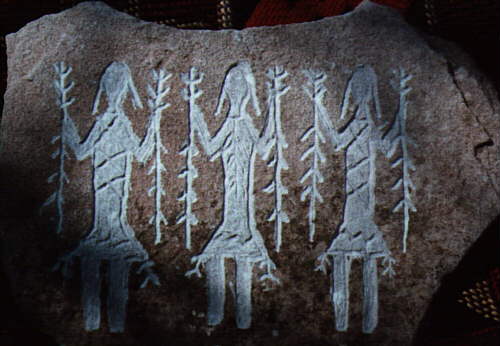
Petroglyphs - Rock Art
Petroglyphs are images incised in rock, usually by prehistoric, especially Neolithic, peoples. They were an important form of pre-writing symbols, used in communication from approximately 10,000 B.C.E. to modern times, depending on culture and location.
The word comes from the Greek words petros meaning "stone" and glyphein meaning "to carve" (it was originally coined in French as pétroglyphe).
The term 'petroglyph' should not be confused with pictograph, which is an image drawn or painted on a rock face, both of which contribute to the wider and more general category of rock art. Petroforms, or patterns and shapes made by many large rocks and boulders in rows over the ground, are also quite different.
The oldest petroglyphs are dated to approximately the Neolithic and late Upper Paleolithic boundary, about 10,000 to 12,000 years ago. Around 7,000 to 9,000 years ago, other writing systems such as pictographs and ideograms began to appear. Petroglyphs were still common though, and some less advanced societies continued using them much longer, even until contact with Western culture was made in the 20th century. Petroglyphs have been found in all parts of the globe except Antarctica with highest concentrations in parts of Africa, Scandinavia, Siberia, southwestern North America and Australia.
Interpretation
These images probably had deep cultural and religious significance for the societies that created them; in many cases this significance remains for their descendants. Many petroglyphs are thought to represent some kind of not-yet-fully understood symbolic or ritual language. Later glyphs from the Nordic Bronze Age in Scandinavia seem to refer to some form of territorial boundary between tribes, in addition to possible religious meanings. It also appears that local or regional dialects from similar or neighboring peoples exist. The Siberian inscriptions almost look like some early form of runes, although there is not thought to be any relationship between them. They are not yet well understood.
Some researchers have noticed the resemblance of different styles of petroglyphs across different continents; while it is expected that all people would be inspired by their surroundings, it is harder to explain the common styles. This could be mere coincidence, an indication that certain groups of people migrated widely from some initial common area, or indication of a common origin.
In 1853 George Tate read a paper to the Berwick Naturalists' Club at which a Mr John Collingwood Bruce agreed that the carvings had '.. a common origin, and indicate a symbolic meaning, representing some popular thought.' In his cataloguing of Scottish rock art, Ronald Morris summarised 104 different theories on their interpretation.
Other, more controversial, explanations are mostly grounded in Jungian psychology and the views of Mircea Eliade. According to these theories it is possible that the similarity of petroglyphs (and other atavistic or archetypal symbols) from different cultures and continents is a result of the genetically inherited structure of the human brain.
Other theories suggest that petroglyphs were made by shamans in an altered state of consciousness, perhaps induced by the use of natural hallucinogens. Many of the geometric patterns (known as form constants) which recur in petroglyphs and cave paintings have been shown to be "hard-wired" into the human brain; they frequently occur in visual disturbances and hallucinations brought on by drugs, migraine and other stimuli.
Present-day links between shamanism and rock-art amongst the San people of the Kalahari desert have been studied by the Rock Art Research Institute (RARI) of the University of the Witwatersrand. Though the San people's artworks are predominantly paintings, the beliefs behind them can perhaps be used as a basis for understanding other types of rock art, including petroglyphs.
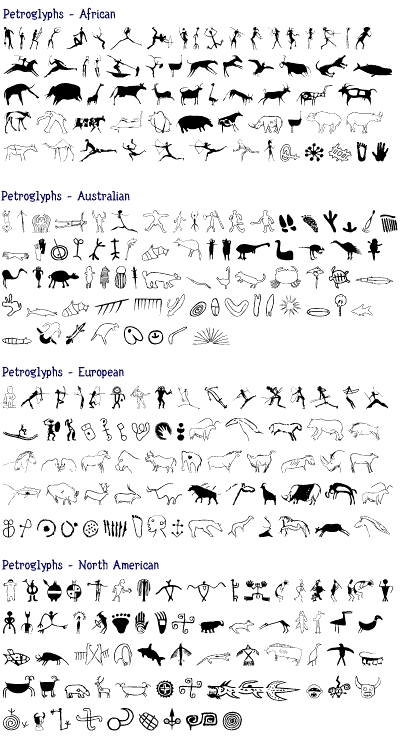
At the Ancient Ruins in West Central Idaho along the Snake River, the story of beings that came from the Stars and a Galactic War was recorded according to Indian Legend well over 30,000 years ago. The petroglyphs depict the beings that came, their interaction with the inhabitants of the ancient city, and the war and destruction that ensued. We are shown their ships which are curiously triangular in shape. Similar to those that have been recently sighted over Colorado, Arizona and California. We are also shown the portal through which the interdimensional beings came.
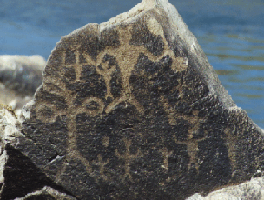
The waging of war between the Star Beings is recorded in the petroglyph to the right. The Star Beings and their counterparts, the two horned priests, are wreaking havoc upon the inhabitants of the Ancient City (represented by the smaller beings who are fleeing.)
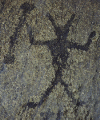
This petroglyph is located on a rock adjacent to the rock shown above. It depicts the two horned Priest. It should be noted that the dumbbell shaped apparatus held in his hand may represent an archtimeter. Reference to this can be found in Alice Bailey's writings, as well as in the hieroglyphs of Egypt. These tools are said to have wielded the power of life and death.
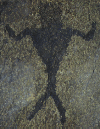
This being is very similar in appearance to Quetzalcoatl who is the Deity in the fabled city of Chichen Itza in Mexico, renowned for its Mayan Pyramids. He is often depicted at the controls of an ancient airship sometimes triangular in design.
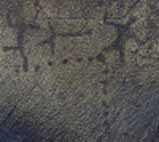
Star Beings emerging from triangular shaped ships
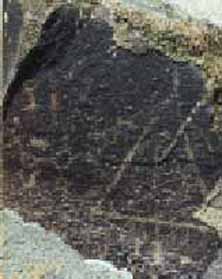
Possible triangular craft with retroflares
Figure inside - Beings Below
Left of the ship 4 entities - Hopi Petroglyphs
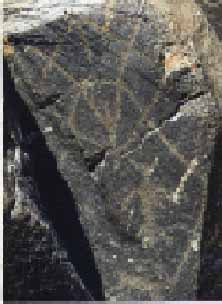
Possible Star Beings - Portal or UFO

The Yei are supernatural Holy People who communicate between the Navaho and their gods. They are usually shown carrying pine boughs, yucca strips and rattles in healing ceremonies. Each petroglyph is hand crafted reflecting images and messages inspired by the Ancient Ones. Native stones are carefully selected for each petroglyph with no two alike.
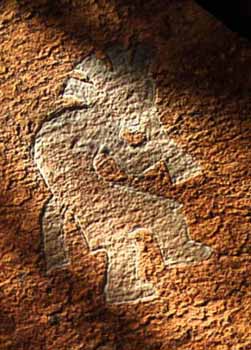
Kokopelli

Kiva
Symbols from stone wall in the Village of the Great Kivas in New Mexico. Note the human, animal, snake and spiral figures were common to the area. Each petroglyph is hand crafted reflecting images and messages inspired by the Ancient Ones. Native stones are carefully selected for each petroglyph with no two alike.

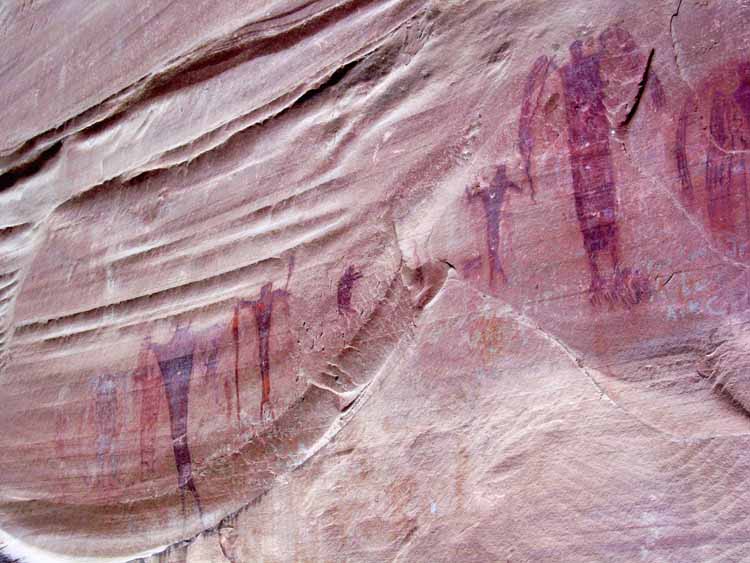
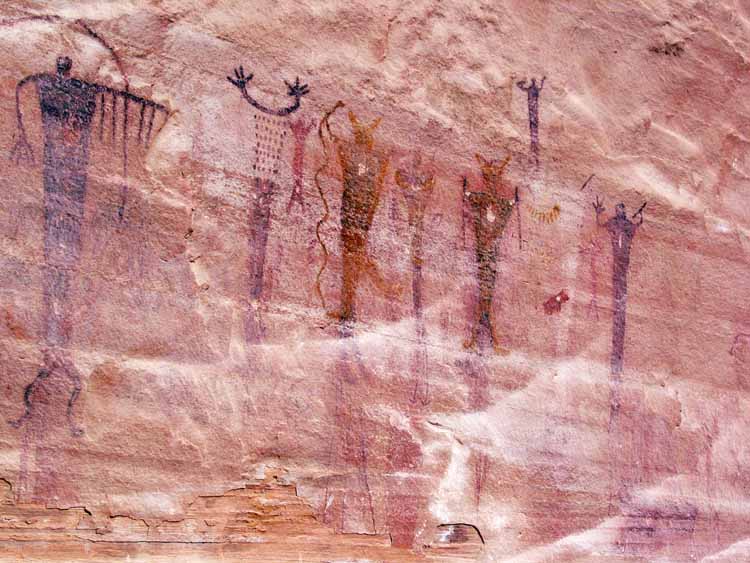
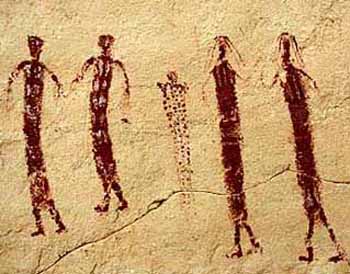
Two Males - Ascending Spirit - Two Females
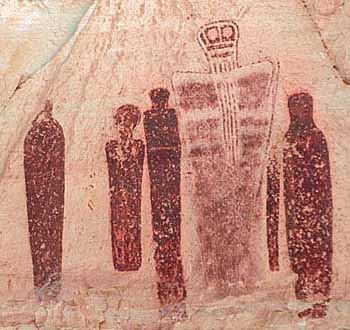
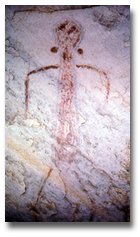
Rock Art in Arkansas
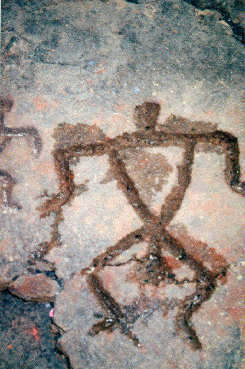
One of the many examples of Hawaiian ki`i pöhaku (petroglyphs - ancient rock carvings) found at Waikoloa. The Hawaiian petroglyphs contain many images of the human figure. It is possible that the images evolved in complexity from the simple angular figure to triangle figures and then to muscular figures. Notice the many angles in the petroglyph.
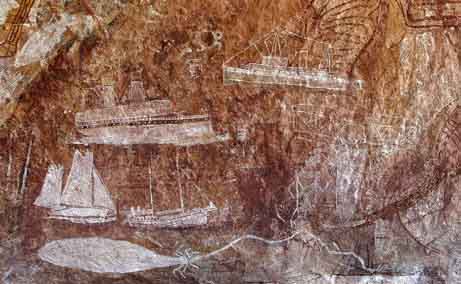
Unusual Rock Art Trove Found in Australia
National Geographic - October 22, 2008
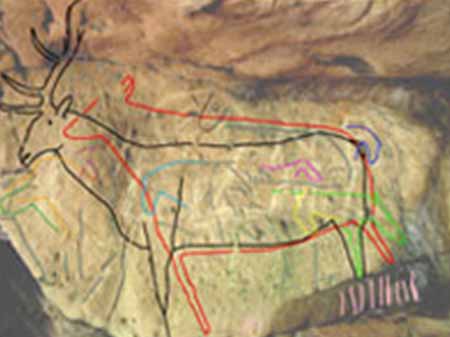
Experts put date to UK rock art - 12,800 years BBC - April 25, 2005
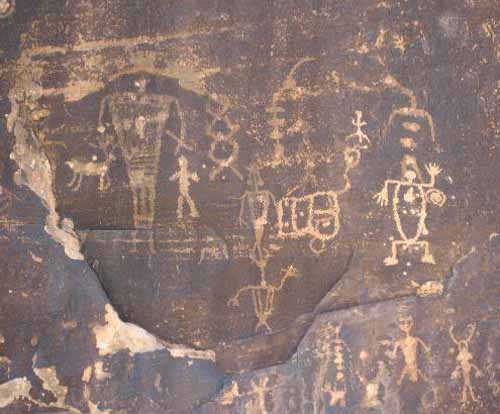
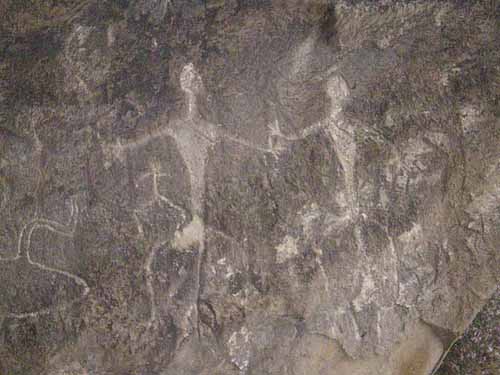
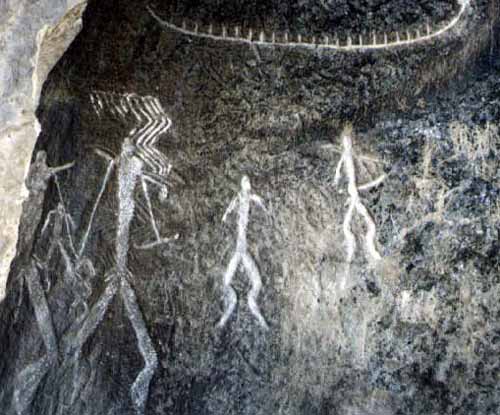
Stone Age petroglyphs Gobustan, Azerbaijan were not discovered by an archeological expedition. Their revelation came about quite by accident. In the 1930s, work was going on there in a stone quarry. The area is full of huge boulders and rock formations. One of the quarry workers noticed some unusual carvings on the rocks. The more the rocks were cut out, the more the paintings could be seen. (Before they had been hidden from view inside a huge pile of boulders.) Even more paintings were found inside what appeared to be man-made caves. Work at the quarry soon stopped so that the paintings could be examined more carefully.
In 1939, archeologist Isaak Jafarzade began the first archeological investigation of the petroglyphs at Gobustan. Between 1940 to 1965, teams identified and documented approximately 3,500 individual rock paintings on 750 rocks. The most ancient petroglyphs have been identified as belonging to the 12-8th century B.C. However, it is assumed that life existed here even earlier and that Gobustan was one of the cradles of civilization. This research was published in a book entitled "Gobustan" in 1978.
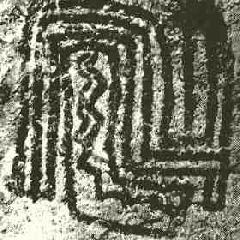
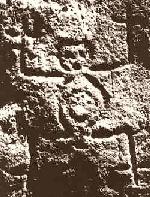
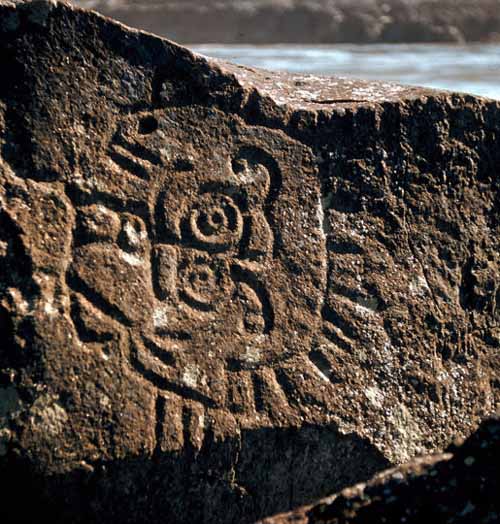
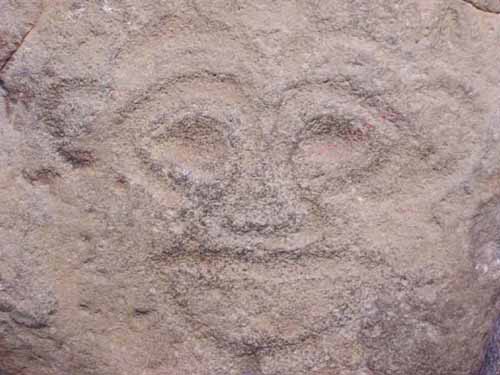
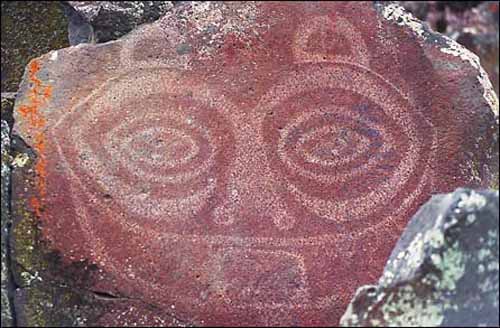
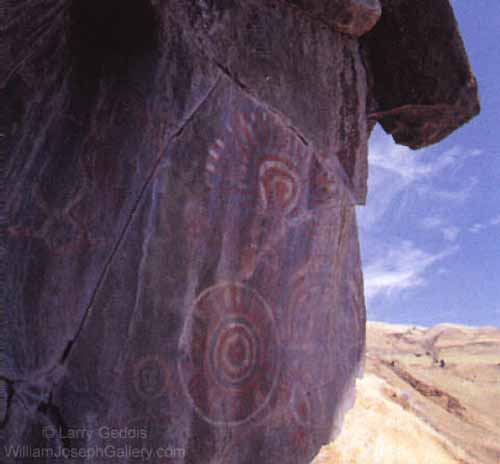
The activity of painting or engraving rocks in Colombia may have begun before the formative period. The scarce references seem to refer to activities which occurred much sooner than just a few years before the appearance of Spanish conquistadors. The differences in rock art themes, the variety of zones, the diversity of picture forms and engravings, seem to indicate that there existed long periods of rock art activity from the Paleoindian to the classic Muisca times. More than 700 pictograph and petroglyph zones have been discovered. Some rural traditions and beliefs have developed from some of the rock art design.
Pictograms - Pictographs
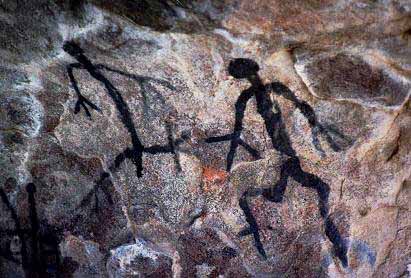
Pictographs are images painted on a rock face. Paints were generally made from pulverized minerals. Red, white, and black were the most common colors.
A pictogram or pictograph is a symbol representing an object or concept by illustration. Pictography is a form of writing whereby ideas are transmitted through drawing. It is the basis of cuneiform and hieroglyphs.
Early written symbols were based on pictograms, pictures which resemble what they signify, and ideograms, pictures which represent ideas; it is commonly believed that pictograms appeared before ideograms. They were used by various ancient cultures all over the world since around 9000 BC and began to develop into logographic writing systems around 5000 BC. Pictograms are still in use as the main medium of written communication in some non-literate cultures in Africa, The Americas, and Oceania, and are often used as simple symbols by most contemporary cultures.
The earliest uses of pictograms in Mesopotamia predated the famous Sumerian cuneiforms (oldest of which date to around 3400 BC). As far as around 9000 BC tokens marked with simple pictures began to be used to label basic farm produce, and around 6000 BC, with the rise of cities and spread of basic craftmanship more complex pictographic tokens were devised to label manufactured goods. Eventually, the tokens were replaced by clay tablets, on which symbols were drawn with a blunt reed called a stylus. The impressions left by the stylus were wedge shaped, thus giving rise to the name cuneiform, wedge-writing.
Though written Chinese is often thought of consisting of pictograms, less than 1% of all characters ever created have their direct origins in pictograms. The letters of the Roman alphabet, however, do have their origins in pictograms. For example, the letter A represented the head of an ox, and if it is turned upside down, a bovine head with horns can be seen.
Pictograms remain in common use today, serving as signs or instructions. Because of their graphical nature and fairly realistic style, they are widely used to indicate public toilets, or places such as airports and train stations. However, even these symbols are highly culture-specific. For example, in some cultures men commonly wear dress-like clothing, so even restroom signage is not universal. Pictographic writing as a modernist poetic technique is credited to Ezra Pound though French surrealists accurately credit the Pacific Northwest American Indians of Alaska who introduced writing, via totem poles, to North America (Reed 2003,p.XIX).
A standard set of pictograms was defined in the international standard ISO 7001: Public Information Symbols. Another common set of pictograms are the laundry symbols used on clothing tags and chemical hazard labels.In countries or regions where two or more languages are used, the typical traffic sign is very often a symbol with no writing on it. This is the case for much of Europe and several parts of Canada. Many of these signs, however, offer an abstract symbol instead of a picture, and they cannot be considered true pictograms.
Cave Paintings

Cave or rock paintings are paintings painted on cave or rock walls and ceilings, usually dating to prehistoric times. Rock paintings are made since the Upper Paleolithic, 40,000 years ago. It is widely believed that the paintings are the work of respected elders or shamans.
When Europeans first encountered the Magdalenian paintings of the Altamira cave, Cantabria, Spain in 1879, they were considered to be hoaxes by academics. The new Darwinian thinking on evolution was interpreted as meaning that early humans could not have been sufficiently advanced to create art. Emile Cartailhac, one of the most respected prehistorians of the late nineteenth century believed they had been thought up by Creationists to support their ideas and ridicule Darwin's. Recent reappraisals and increasing numbers of discoveries have illustrated their authenticity and indicated the high levels of artistry of Upper Palaeolithic humans who used only basic tools. Cave paintings can also give valuable clues as to the culture and beliefs of that era.
The age of the paintings in many sites remains a contentious issue, since methods like radiocarbon dating can be easily misled by contaminated samples of older or newer material, and caves and rocky overhangs are typically littered with debris from many time periods. The choice of subject matter can indicate date such as the reindeer at the Spanish cave of Cueva de las Monedas which imply the art is from the last ice age. The oldest cave is that of Chauvet, and is 32,000 years old.
The most common themes in cave paintings are large wild animals, such as bison, horses, aurochs, and deer, and tracings of human hands as well as abstract patterns, called Macaroni by Breuil. Drawings of humans are rare and are usually schematic rather than the more naturalistic animal subjects. Cave art may have begun in the Aurignacian period (Hohle Fels, Germany), but reached its apogee in the late Magdalenian (Lascaux, France).
The paintings were drawn with red and yellow ochre, hematite, manganese oxide and charcoal. Sometimes the silhouette of the animal was incised in the rock first. Stone lamps provided some light. Abbé Breuil interpreted the paintings as being hunting magic, meant to increase the number of animals. As there are some clay sculptures that seem to have been the targets of spears, this may partly be true, but does not explain the pictures of beasts of prey such as the lion or the bear.An alternative and more modern theory, based on studies of more modern hunter-gatherer societies, is that the paintings were made by Cro-Magnon shaman.
The shaman would retreat into the darkness of the caves, enter into a trance state and then paint images of their visions, perhaps with some notion of drawing power out of the cave walls themselves. This goes some way towards explaining the remoteness of some of the paintings (which often occur in deep or small caves) and the variety of subject matter (from prey animals to predators and human hand-prints). However, as with all prehistory, it is impossible to be certain due to the relative lack of material evidence and the many pitfalls associated with trying to understand the prehistoric mindset with a modern mind.

Lascaux is a complex of caves in southwestern France famous for its cave paintings. The original caves, located near the village of Montignac. They contain some of the earliest known art, dating back to somewhere between 13,000 and 15,000 BCE, or as far back as 25,000 BCE.
Geoglyph
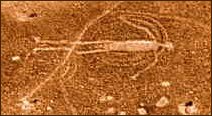
A geoglyph is a drawing on the ground, or a large motif, (generally greater than 4 metres) or design produced on the ground, either by arranging clasts (stones, stone fragments, gravel or earth) to create a positive geoglyph (stone arrangement/alignment, petroform, earth mound) or by removing patinated clasts to expose unpatinated ground (negative geoglyph).
Some of the most famous negative geoglyphs are the Nazca Lines in Peru. Other areas with geoglyphs include Western Australia. Hill figures, turf mazes and the stone-lined labyrinths of Scandinavia, Iceland, Lappland and the former Soviet Union are types of geoglyph. The largest geoglyph is the Marree Man in South Australia.
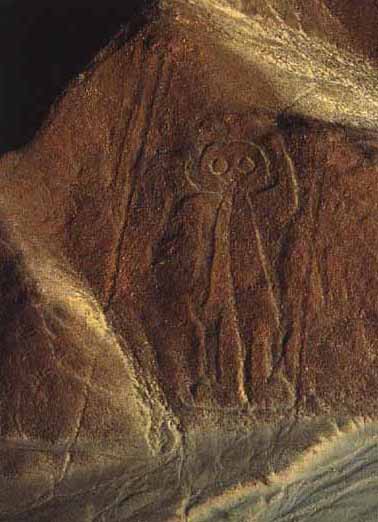
Nazca Lines
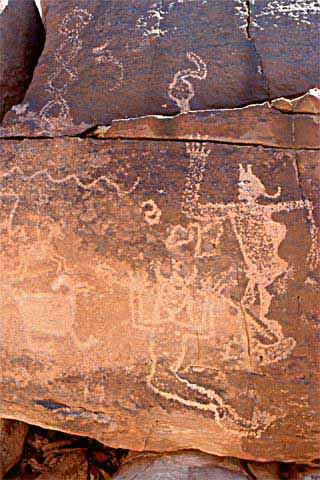
Amphibious Gods - Serpent - DNA - More
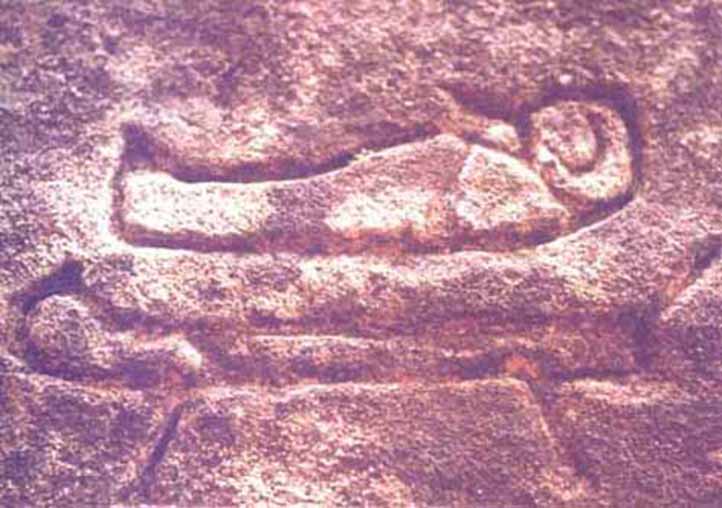




1 comments:
Thanks for sharing this post. The complex painted caves of Lascaux are located in the Dordogne region. The awe-inspiring paintings are also described as ‘the antediluvian Sistine Chapel’.1200 visitors daily visit the cave. The initial climatic situation had been re-build and maintained with the assistance of a fully-automated system. The original caves were made in 1980 called as Lascaux II. For more details refer Caves Of Lascaux
Post a Comment